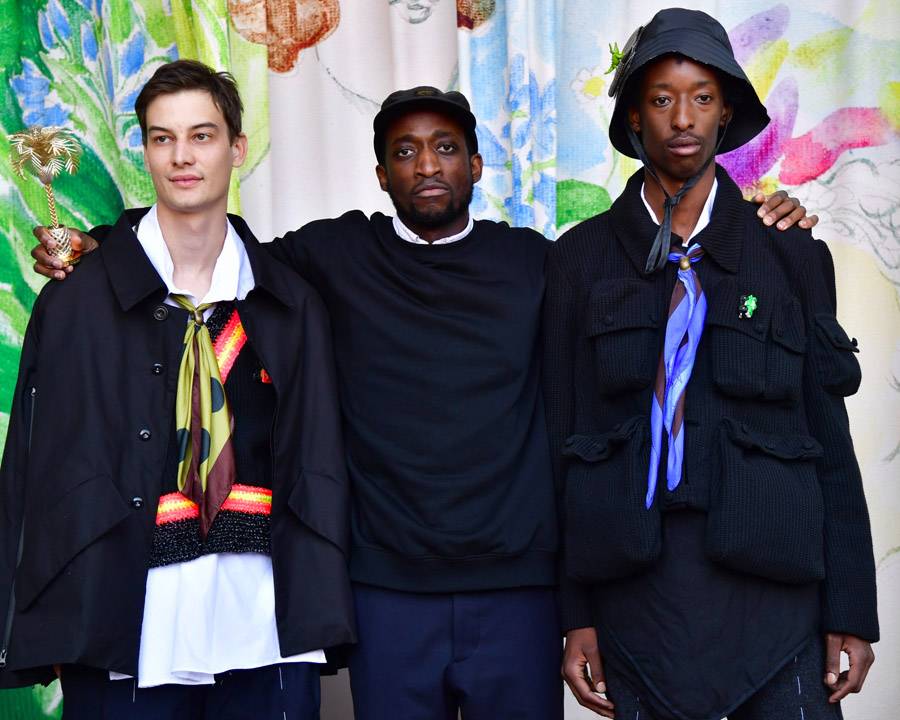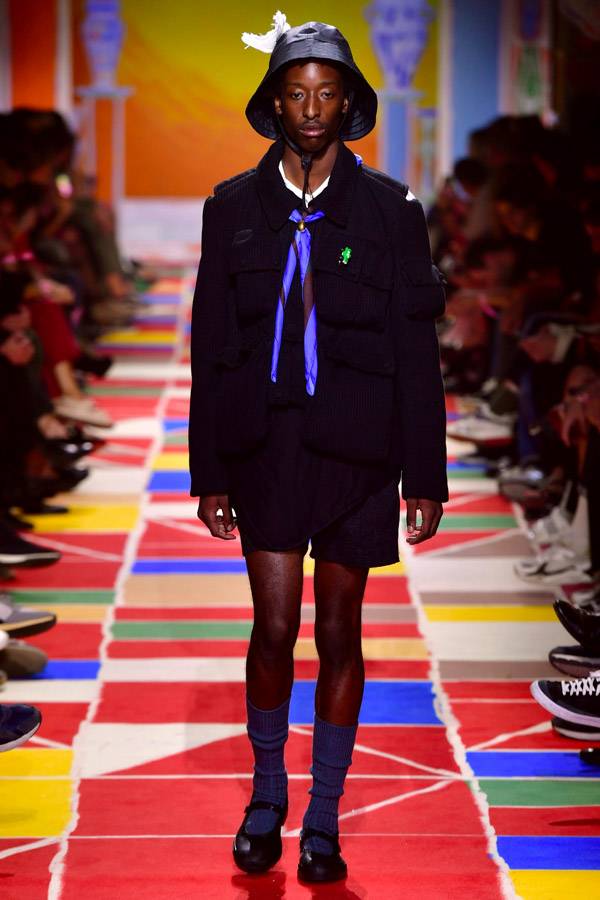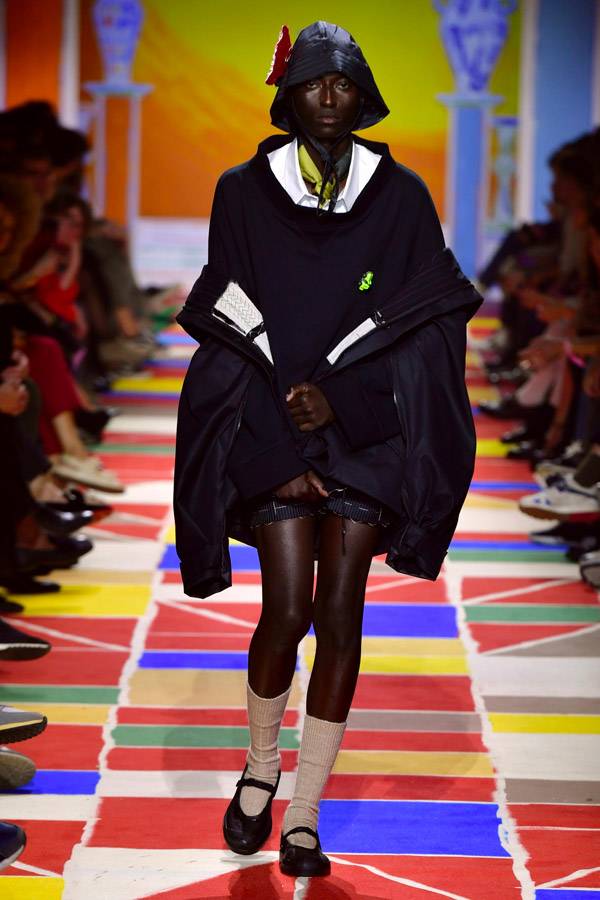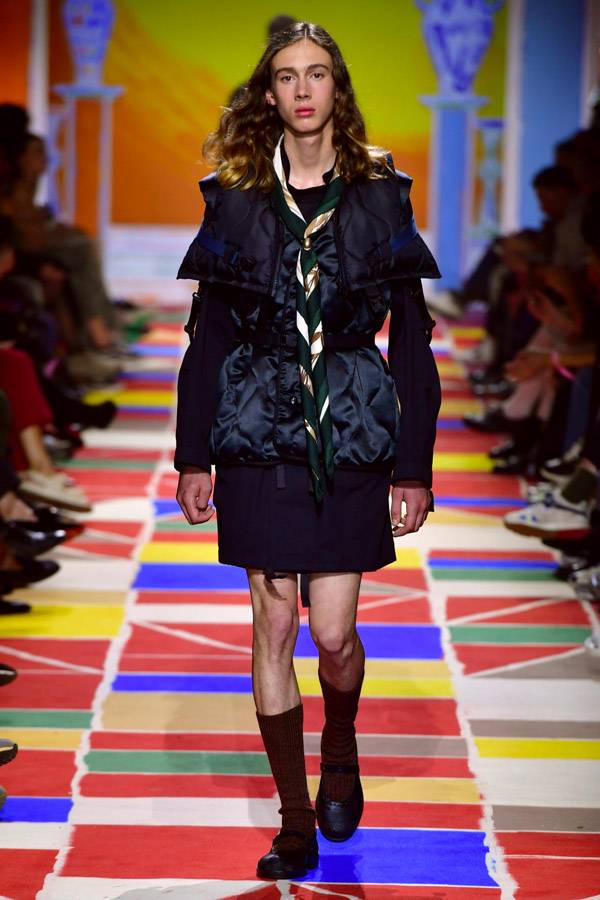
18
Who is Ifeanyi Okwuadi, the young London designer who won the Hyères Festival?
This weekend, in Hyères, a young 27-year-old London designer, Ifeanyi Okwuadi, won the Première Vision Jury Prize, the final award of the International Festival of Fashion, Photography and Fashion Accessories. Through a men’s wardrobe reinventing the codes of tailoring, the designer managed to seduce Louise Trotter, artistic director of the house of Lacoste and president of the fashion jury of the 36th edition of the festival. We met with a committed and inspired young designer, at the beginning of a career that we hope will flourish.
Published on October 18, 2021. Updated on May 31, 2024.

On Sunday, October 17, in the sunny courtyard of the Villa Noailles in Hyères, the enthusiastic applause of the audience was quickly replaced by a pious and tender silence. Ifeanyi Okwuadi, who had just won the Première Vision Grand Jury Prize at the Hyères Film Festival, in the fashion category, broke down in tears a few moments after receiving her trophy, overwhelmed by emotion. For the young man, who then confided in Number, the Hyères adventure exceeded all his expectations: “The Hyères Festival is a dream. I’ve been following what’s going on there for years and I’ve always been impressed by the work of the finalists. So being myself here, and winning the Jury Prize… It’s really a dream come true.”
It is with his collection entitled “Take the Toys from the Boys” that the Londoner stood out from the nine other finalists of the competition, by offering a sober, elegant and playful men’s wardrobe, combining know-how and innovation. The seven silhouettes presented by the designer borrow their components from the traditional uniforms of Anglo-Saxon students and boyscouts: short, wide shorts, high wool socks, silk scarves tied around the neck, pea coats and trench coats lined with tweed… A structuring element of the collection, the Tweed Harris, handwoven from virgin wool in Scotland, reworked in patchworks, hidden in the linings of coats or unveiled thanks to large openings on the back or on the collars of some pieces.

Paradoxically, Ifeanyi Okwuadi’s men’s dressing room is mostly inspired by women: “The project is inspired by a group of women who protested against nuclear weapons in the 1980s [the Greenham Common Women’s Peace Camp, editor’s note], for 20 years; Each of the looks in my collection refers directly to one of the manifestations of the movement.” The visible seams and the mesh of some pieces are reminiscent of the railings of the military base that the activists had appropriated, and the slightly distended and widened neckline of the sweaters refers to the violent clashes with the police during the demonstrations. Beyond these historical female figures and the message of peace associated with them, the designer says he is inspired by women more generally: “I’m mostly interested in women’s fashion, which is quite strange for a men’s fashion designer, I guess… I like the idea of translating what I like about a women’s wardrobe into men’s clothing. It allows me to develop softer silhouettes.”
The young designer’s creative adventure began ten years ago, in a mythical place of Anglo-Saxon men’s fashion, on Savile Row. In this London street known internationally for its high-end suits – some of which have been there since the early nineteenth century – Ifeanyi Okwuadi cut her teeth at Cat and the Dandy, a renowned establishment specializing in the manufacture of tailor-made suits. “Before that, I was the basic young Londoner: my life revolved around football, like that of most of the boys around me and my generation,” he confides. At the age of 17, his apprenticeship at Cat and the Dandy and his training in textile design at Ravensbourne University opened up new horizons and led him to develop a very personal style, closely linked to Anglo-Saxon history and culture.

As a little boy, Ifeanyi Okwuadi would have dreamed of being a Scout: “I think it’s because of this discipline that they have. In my opinion, it is very important for the young people of our generation to learn to be cared for, orderly and organised, but also to respect each other, all fundamental aspects of Scouting, it seems to me.” On one of the pieces of his collection presented in Hyères, there are scout badges illustrated by the founder of the movement, Robert Baden-Powell. A way for the young designer to give a nod to the traditional uniform, from which he draws inspiration in his collection, but also to refer to childhood and its innocence: “I would like my clothes to remind people of their childhood and what it meant to them… And that through my work, we come to think about the world in which we would like to see our children grow up.”
This ambition is served by other surprising and structuring elements, such as the diversion of Kinder toys or the use of “scoubidou” thread. On the suit jackets and sweaters of the collection, small colorful miniature cars made from Kinder eggs sometimes become brooches, sometimes cufflinks, infusing a playful and joyful character into the silhouettes. For her piece created in collaboration with the house of Lemarié, as part of the 19M des Métiers d’Arts de Chanel prize, Ifeanyi Okwuadi took yellow, orange and black scoubidou threads, worked with crochet to adorn the V-neck and the bottom seam of a classic sweater. While these details are associated with the designer’s message of peace and innocence, it’s also a way to spark curiosity: “All these playful elements that refer to childhood intrigue people and make them want to know more about my work. It makes my basic message more approachable.”

For the young man, the future already looks bright. Thanks to the many meetings occasioned by the festival, many projects should see the light of day: “It’s obviously too early to talk about it, but just being able to showcase my work here has opened up a whole bunch of opportunities for me, and these future prospects are very exciting.” In the coming months, the designer is due to join a Master of Arts at the famous Central Saint Martins in London, and wishes to develop his social networks and communication around his project: “I have to be able to make creation and communication coincide. I want people to hear my message of peace, love… I know it sounds very cheesy but that’s my goal and the DNA of my work: to infuse a positive spirit into high-quality products.”. What is certain is that the designer will be back next October, to present a new collection at the 37th edition of the Hyères Festival, where he is already eagerly awaited.















